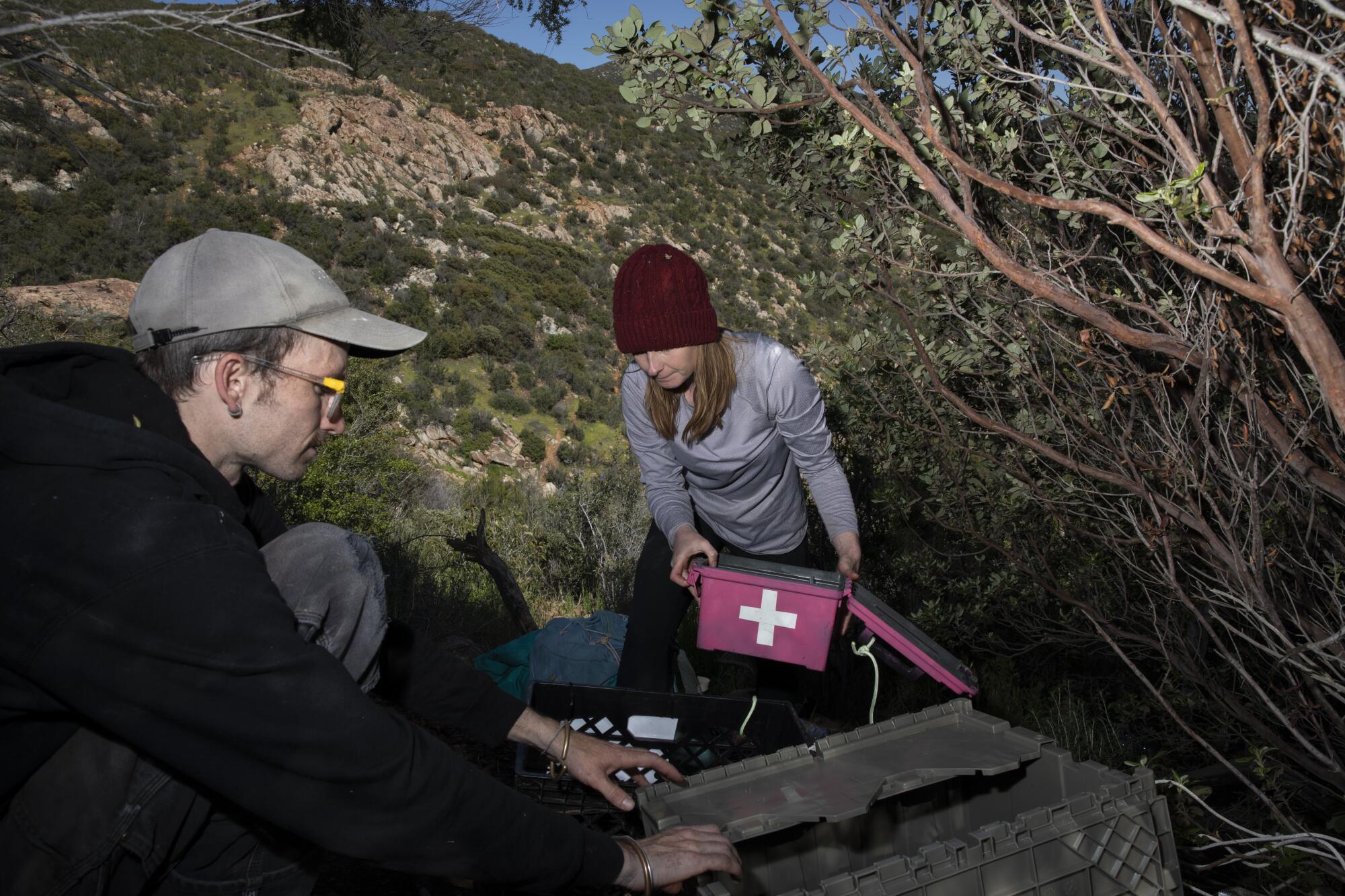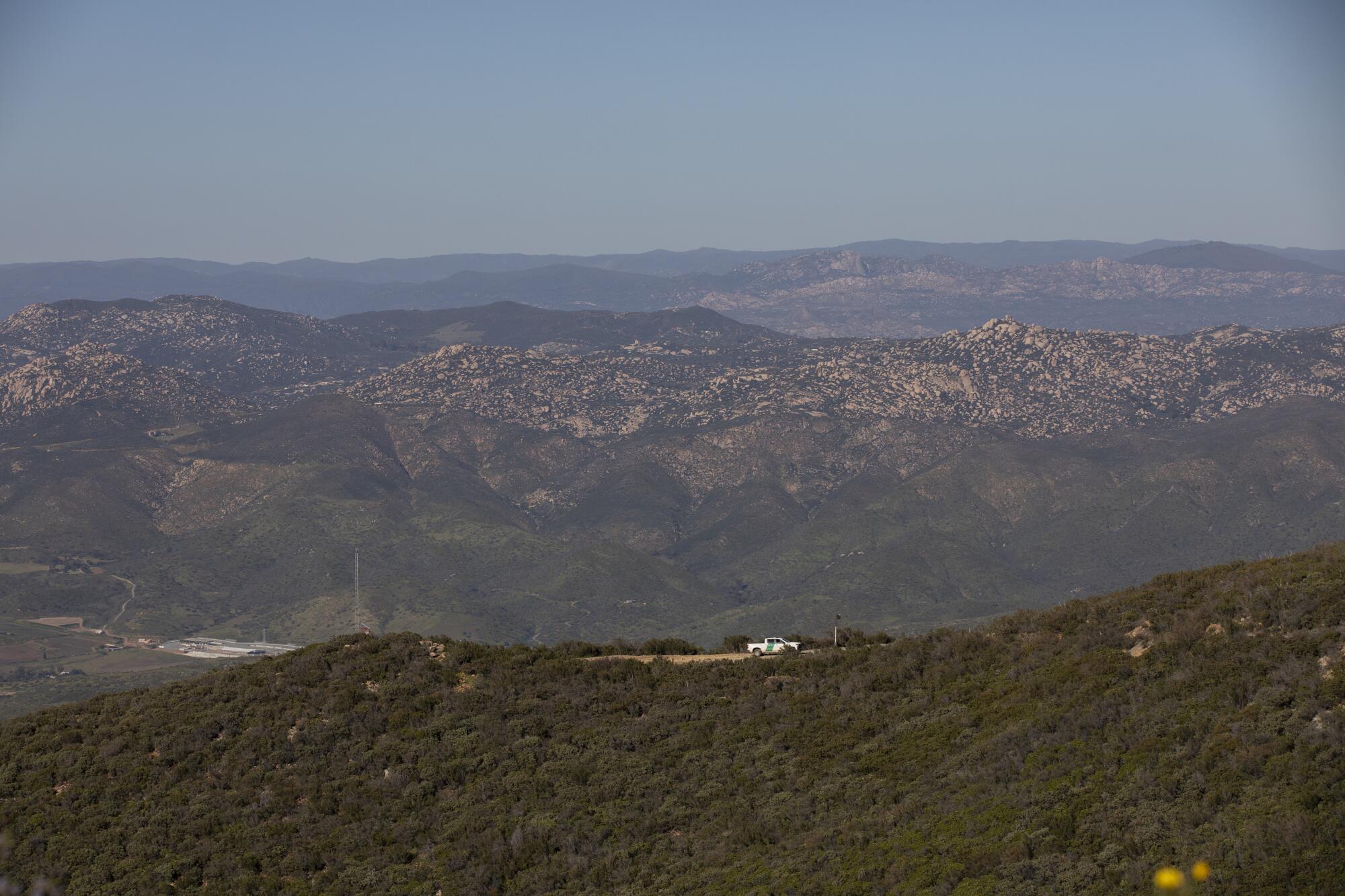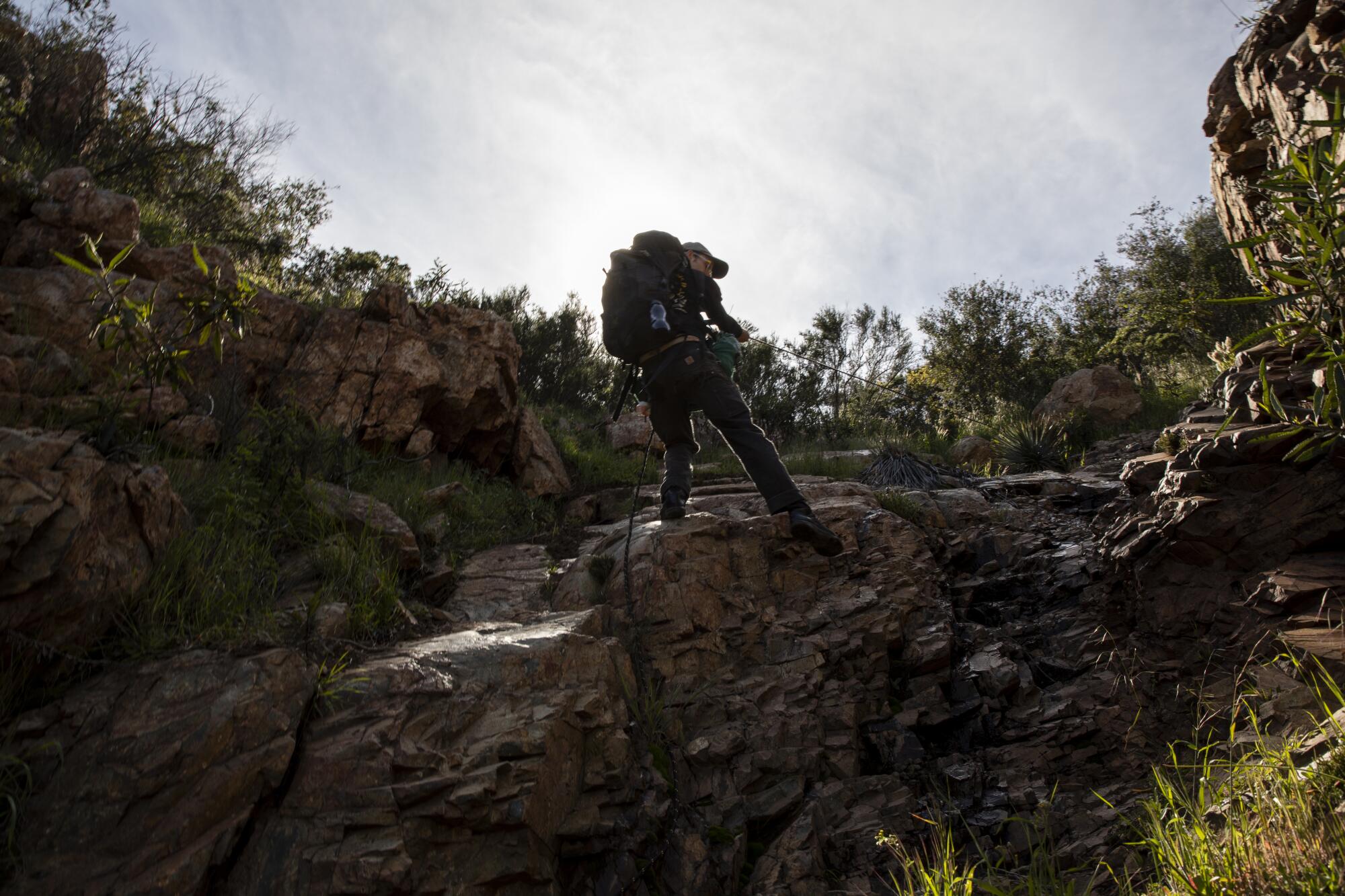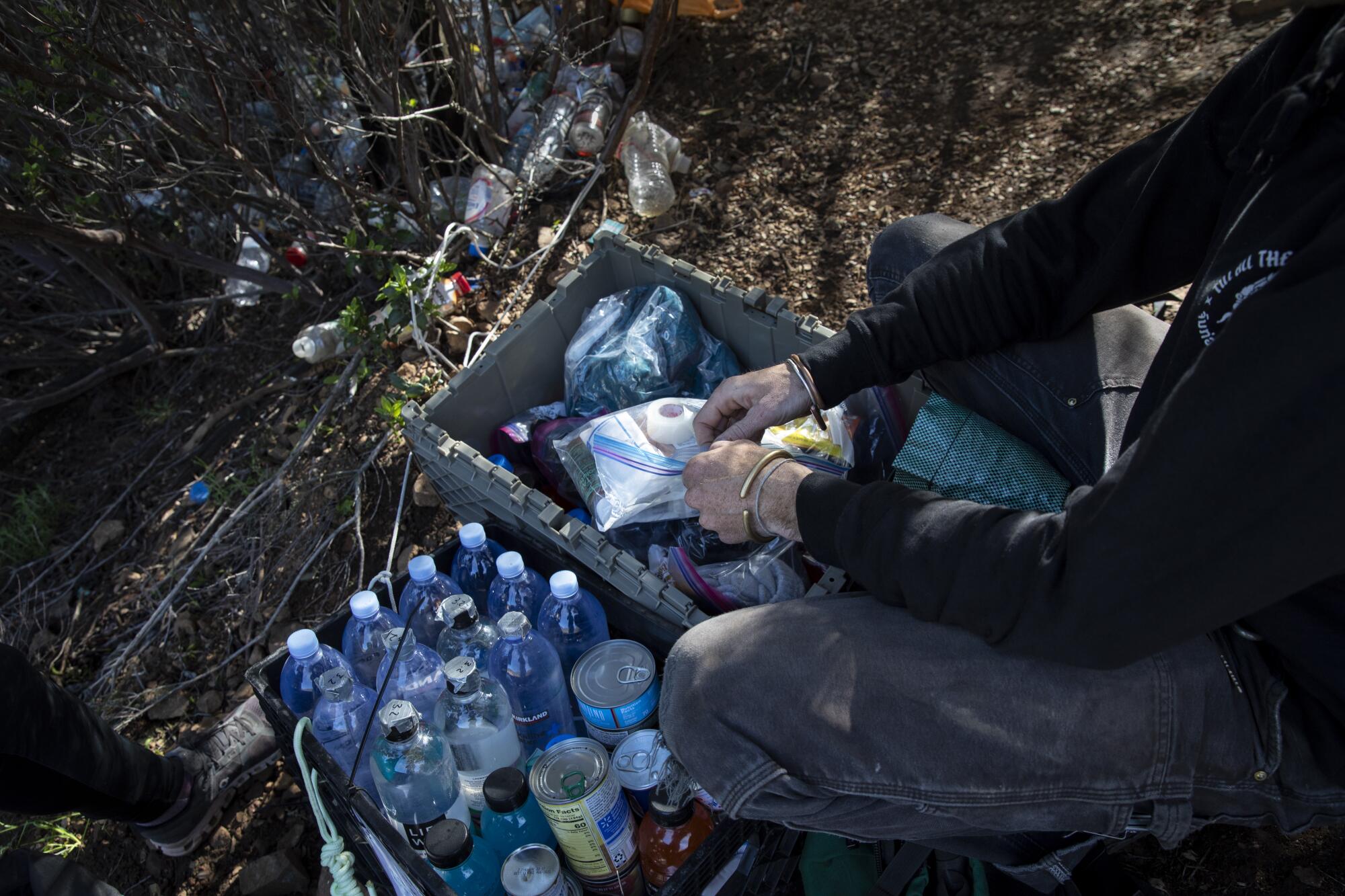
Humanitarian volunteers confronted two Border Patrol agents at the end of a trail and filmed the conversation.
- Share via
San Diego — Early on a recent Saturday morning, a group of humanitarian volunteers hiked, slipped and scaled steep rocks down an Otay Mountain trail marked by Electrolit bottles and clothing left behind by migrants.
Along the way, the volunteers left crates full of water, canned food and first aid supplies, hoping to prevent the deaths of people trying to cross the border there.
When they turned around and hiked back to the cars they had left — near a rescue beacon on a remote dirt road mostly used by Border Patrol agents — they found one drop site sabotaged. The supplies they had just placed there were opened and dumped all over the ground. The group believes that Border Patrol agents were responsible for the destruction.
“It was so painful, and it was painful in a way that we didn’t know how to express,” said Emmet Daler Norris, 28, a doctoral student at Scripps Institution of Oceanography in San Diego and long-time humanitarian volunteer.
The incident occurred just a couple of weeks after eight people lost their lives trying to cross into the United States by boat at San Diego County’s Black’s Beach, and during a weekend when Border Patrol had warned about potentially dangerous conditions in the mountain area because of approaching winter storms.
According to Customs and Border Protection, the parent agency to Border Patrol, San Diego Sector leaders have emphasized to agents that they should neither remove nor destroy humanitarian aid left in the Otay Mountain Wilderness. The incident is now under investigation, the agency said.
“U.S. Customs and Border Protection takes allegations of misconduct seriously and this incident has been referred to CBP’s Office of Professional Responsibility,” the agency told the Union-Tribune via email.

However, humanitarian groups have previously documented instances of agents destroying supplies left for migrants along the border.
In 2018, humanitarian volunteers in Arizona posted a video showing Border Patrol agents destroying water jugs they had left in the desert. The video went viral.
The situation escalated when Border Patrol agents placed a camera to monitor a building where the volunteers often stored supplies. They ended up arresting one of the volunteers and charging him with harboring undocumented immigrants. The volunteer was ultimately found not guilty.
David Greenblatt, 50, chief of surgery at Sharp Coronado Hospital and a long-time volunteer with San Diego water-drop organizations, recalled a time more than five years ago when the volunteers similarly found their water jugs slashed. But by adjusting drop locations and applying social media pressure to Border Patrol, Greenblatt said, the volunteers were able to get the destruction to stop.
“Really we have not seen this in such a blatant manner for the last several years,” Greenblatt said.
A deadly mountain
Though water drops intended to help migrants survive hostile desert conditions have happened for years in San Diego County, the efforts on Otay Mountain are relatively new.
After participating in some search and rescue efforts for missing migrants in the Otay Mountain area, Greenblatt said, Borderlands Relief Collective, which formed in the past year, decided to focus its attention there.
While the desert’s heat can make migrant treks deadly, the environment in the mountains on the border can also prove fatal. Extreme heat and cold can lead to heat exhaustion or hypothermia. Steep and rugged terrain over rocks and dense brush can cause wrenched ankles or worse. And once a migrant is injured and left behind by the group they’re crossing with, the extreme temperatures can quickly turn the situation into an emergency.
The San Diego Sector of Border Patrol, which stretches 60 miles east from the Pacific Ocean and reaches north along the coastline, has recorded 2,575 rescues since Oct. 1. Officials were unable to provide a number specific to the Otay Mountain area.
Since at least 2021, Border Patrol has said that the mountain is one of the most frequently crossed areas of the border. That year, agents told the Union-Tribune they were apprehending about 200 people per day on the mountain.

Greenblatt said that when the collective helped with search and rescue efforts and began scouting around the mountain region for where to leave supplies, they could tell from discarded items along trails just how often people were coming through.
“It became very, very obvious there was a pressing need for us to focus on providing and leaving supplies in these areas because there were so many emergencies and so many deaths that have occurred in this area over the last several years,” Greenblatt said.
The volunteers noticed that often the supplies they left would be fully consumed within two weeks, he said.
The volunteers have also met several migrants on the mountain during supply drops — something that didn’t happen as often in the desert.
Greenblatt recalled meeting a father and teenage son who said they had been on the mountain in pouring rain for two days. The father was shaking uncontrollably and seemed to have symptoms of hypothermia, Greenblatt said.
“They told us they could go no further,” Greenblatt recalled. “We explained to them that we could not give them rides in our vehicles because that is considered a federal felony crime, but if they really needed help we would help them contact the authorities understanding they would be arrested by Border Patrol.”
The family ultimately decided to turn themselves in to Border Patrol to get medical treatment.
The experience still sticks with Greenblatt.
“All of this heated rhetoric, political rhetoric that we hear about that characterize migrants as criminals, as dangerous cartel criminals, it really is not borne out by our direct experiences doing this work,” he said. “The people that we encounter are just regular folks, often not prepared for the incredibly difficult and hazardous journeys that they undertake in the deserts in the mountains.”
Disappearing and destroyed supplies

As the collective began to leave supplies on the mountain, the volunteers noticed that sometimes everything — including the crate they left the water, food and first-aid kits in — would disappear.
“It’s very clear to us when things have been used or just destroyed,” Norris said. “We find our bottle caps and our bottles and cans all over the mountainside, and when there are several gallons gone or a couple of handwarmers remaining it’s clear people have taken what they’ve needed. When everything is gone, and there’s not a single trace of it being consumed, not a single trace of any of our supplies along that trail, it’s quite clear that it was not used, and it was just taken.”
On March 18, the group went to resupply drop sites on a path that seemed to be heavily trafficked by migrants. A search and rescue group had recently found a missing and injured migrant nearby, according to Greenblatt. The group also added a third drop site further down the mountainside.
On the way down the mountain, the group saw a Border Patrol agent surveilling that part of the mountain.
They made their way down to the three locations, then spent a little time enjoying waterfalls by the final drop site before turning around and heading back up the mountain.
When they reached the second drop site, they were shocked by what they saw.
Every water bottle was poured out, every can of food opened, with some of the beans smeared on the socks. According to Greenblatt, some of the supplies smelled of urine.
“It was very visible that all of our stuff had been opened and dumped out,” said Kirsten Zittlau, a San Diego immigration attorney who volunteers regularly with the group. “They even opened the socks and beanies and stuff like that and dumped those on the ground, just smashed up the crate for good measure.
“It hit us all pretty hard,” she added. “I think initially we were just kind of demoralized and shocked and sad and mad and then determined to take action — and we’re not giving up. We can’t give up. People’s lives depend on it.”
A confrontation with agents

While two of the volunteers stayed to document the mess and clean up, a few hiked ahead to try to find those responsible for the destruction. At the trailhead, they found two Border Patrol agents, whom they confronted.
Initially, according to Norris, who was one of the first to reach the agents, the two agents admitted to having ransacked the supplies. However, it was only later in the conversation that the volunteers thought to film.
In the video reviewed by the Union-Tribune, volunteer Kasia Kenitz, 34, asks the agents whether destroying water and food supplies is part of their job responsibilities.
“It’s abandoned property,” says one agent.
“You could carry it to your car then,” Kenitz responds.
“No, it’s a long hike,” the agent says. “Why would I do that?”
Later in the video the agent says that agents frequently find abandoned property that migrants leave behind.
“And what do you do with it?” Kenitz asks.
“We destroy it,” the agent says. “We try to clean it up—”
“That’s cleaning it up?” Kenitz interjects.
“That’s one of the things we try to do,” says a second agent. “We either empty it out, or we try to clean it up. That one was too far for us to bring back.”
In another part of the video, the second agent denies destroying the supplies.
CBP confirmed that the two men whom the volunteers filmed are Border Patrol agents.
Attorney Zittlau noted that property is only considered abandoned legally after it has been left for 10 days.
“I’ve checked out all the regulations,” she said. “If anything, they’re the ones who are violating legal regulations. They turned humanitarian supplies into litter.”
Since then, the volunteers put signs on their supply crates that read: “Do not destroy. Do not remove. This is NOT garbage, and NOT abandoned personal property. These are HUMANITARIAN AID SUPPLIES to decrease the risk of death for people using this trail; protected by federal case law, the Religious Freedom Restoration Act of 1993; and the U.S. Constitution.”
On Thursday, Norris and Kenitz hiked back through the route to check the sites, restock supplies and collect trash.
The crates they had refilled just two weeks prior were still intact, and nearly all of the supplies at the previously destroyed drop spot had clearly been used by migrants.

More to Read
Sign up for Essential California
The most important California stories and recommendations in your inbox every morning.
You may occasionally receive promotional content from the Los Angeles Times.













